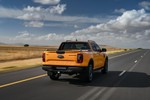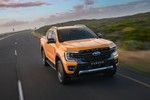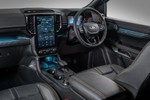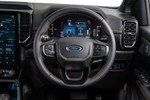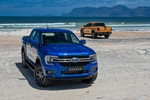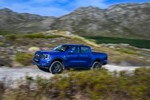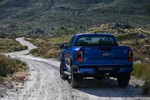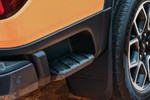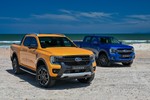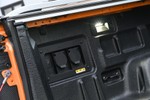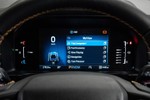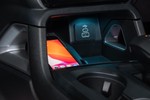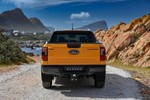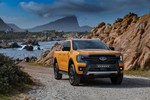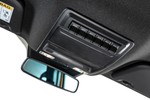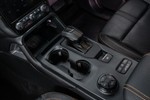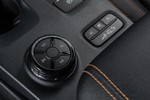Ford Ranger (2022) Launch Review
It’s finally here! After driving a pre-production unit of the new, locally built Ford Ranger earlier this year, we could not wait for the production version to go on sale in South Africa. Well, has the Blue Oval’s next-generation bakkie been worth the wait? To find out, we embarked on a 2-day adventure across the Breedekloof Valley…
The new Ranger has a lot to live up to. The Blue Oval built no fewer than 875 000 units of the 1st-gen T6 bakkie between 2011 and 2022 (worldwide) and, in the runup to the local introduction of the 2nd-gen T6 bakkie, Ford Motor Company of Southern Africa (FMCSA) invested R15.8 billion in its Silverton assembly- and R600 million in its Struandale engine plants. FMCSA will have the capacity to build 200 000 new Rangers a year, plus it has created an additional 1 200 jobs.
What’s New?

The new Ford Ranger is shown here in Wildtrack (left) and XLT (right) guises.
A lot. The Ford Ranger has changed dramatically – inside and out. The T6 platform has been modernised and the bakkie’s front end optimised to improve airflow and accommodate V6 engines, as well as a secondary battery. Ford claims that it has future-proofed this platform, but would not be drawn on the possibility of producing electrified or hybridised versions. We reckon that’ll happen sooner rather than later and that Ford has already begun laying the groundwork for it.
More: 292 kW Ford Ranger Raptor – Indicative Pricing
Styling is subjective, but the new bakkie’s exterior execution, which includes cues such as C-shaped daytime running lights and the American pick-up-like tailgate, is undeniably bold and striking. It’s a fantastic take on what a modern bakkie should look like, and the Ranger drew admiring stares everywhere we drove during the launch event. Also, it’s impossible not to notice the Wildtrak’s dazzling Cyber Orange finish!

The Ranger’s tailgate design was evidently inspired by those of its American pick-up truck siblings.
Ford has extended the new Ranger’s wheelbase by 50 mm and extensively reworked its suspension in pursuit of a more refined ride quality. The front wheels have been moved more forward and outward (by 50 mm) to shorten the front overhang, as well as improve the approach angle and wheel articulation. Off-road capability also benefits from an improved departure angle.
Apart from the usual 2H, 4H and 4L ranges, Ranger 4x4s offer a choice of 6 off-road drive modes, while the Wildtrak comes equipped with an electronically controlled full-time four-wheel-drive system that dynamically apportions drive between the front and rear axles as needed.
Some of the biggest changes are in the cabin, which is dominated by a portrait-orientated touchscreen infotainment system and a fully digital instrument cluster. These inclusions alone represent a huge step forward for the bakkie segment, because every single derivative in the line-up has these elements (although they aren’t all as expansive or feature-reach as in the Wildtrak).

Bakkie cabins have long been described as “becoming more SUV-like”, but in the case of the Ranger’s interior, it rings true!
There’s nothing analogue about the cabin whatsoever, but it’s great to see there is still some conventional switchgear on the fascia, so you don’t need to fear that you will have to spend your time sifting through the infotainment system’s menu to access (or adjust) basic onboard functions. Yes, there are overlaps, but sometimes it’s just easier to turn the knob that controls the interior fan with just one click, instead of having to prod a touchscreen button.
The system is called SYNC4A and, depending on trim level, it comes with either a 10.1- or 12-inch touchscreen. Its interface is attractive and reasonably straightforward to use. There are some fun touches, such as the sketchpad, plus it’s Android Auto/Apple CarPlay compatible.

Under the Ranger’s fascia sits USB-A and USB-C ports, as well as a wireless charging pad.
Ford claims there are marked improvements in the Ranger’s interior materials, fit-and-finish, plus cabin refinement (through improved suppression of noise, vibration, and harshness). The Blue Oval is also said to have extensively surveyed its current Ranger customers to better understand product issues, learn about what they expect of their bakkies and so on. The result is a fascinating blend of sensible practicality, nifty little features (that you never knew you needed) and 21st-century digitalisation. The front cupholders, for example, are positioned directly adjacent to the ventilation outlets; that way, your cooldrink/water bottles will stay chilled.

This little step makes a world of difference when it comes to accessing the load tray.
Then there’s a cleverly positioned step behind the rear-wheel arch that facilitates easier access into the load tray; when you deploy the tailgate, it doubles as a workbench, complete with places to clamp items as well as an integrated ruler; for those who want to fit accessories, Ford has availed a bank of cool aircraft-style auxiliary switches behind the roof-mounted sunglasses holder; finally, if you frequent drive-thrus, there’s a place for your French fries – no, we are not kidding.

Drivers can switch between 2H, 4H and 4L using a rotary controller on the centre console, but note the 4A setting on the Wildtrak, that’s for engaging automatic four-wheel drive.
What’s on Offer?
To begin with, FMCSA is introducing double-cab derivatives of the new Ranger; the single- and extended-cab variants of the so-called T6.2 will appear in local showrooms in early 2023.
FMCSA says it has a few thousand confirmed pre-orders that it needs to fulfil first – the Silverton facility is currently churning out around 400 units a day. Of course, the plant will have the capacity to produce more bakkies, but it’s busy scaling up, so don’t expect to see many new Rangers delivered until the end of the first quarter of 2023. FMCSA does expect demand to outstrip supply; if you want the range-topping Raptor… you’ll have to wait until February.

Every derivative in the Ranger line-up is fitted with a digital instrument cluster.
There are 4 trim levels in the new Ranger line-up: Base, XL, XLT and Wildtrak. The base and, to some extent, XL versions are aimed at the workhorse market; they offer business owners value-for-money capability. The XLT and Wildtrak, in turn, cater for the leisure (or lifestyle) bakkie market, but if you need to “get their load trays dirty”, they’re up to the task. Impressively, every derivative gets the portrait infotainment screen; there’s no such thing as a “poverty-spec” Ranger.
More: 2022 Ford Ranger specs, features and option packs
Engine-wise, the headline news is the introduction of a 6-cylinder turbodiesel engine. We first experienced the new 184 kW/600 Nm 3.0-litre V6 in the Ranger-based adventure SUV, the Everest, and were impressed with its refinement and punch. The motor’s paired with a 10-speed automatic transmission, which has been upgraded with a new torque converter, as well as revised software.

Power sockets are fitted in the side of the Ranger’s load tray.
The 2.0-litre biturbo diesel is carried over. It produces slightly less power than the outgoing model, but we’re told its performance is more flexible; the 154 kW/500 Nm motor also has the updated 10-speed auto ‘box. At the lower end of the range is a 125 kW/405 Nm 2.0-litre single-turbo diesel, which is available in conjunction with either a 6-speed manual- or 6-speed automatic ‘box.
What’s it like to drive?

It’s still a bakkie and its suspension can jiggle over bumps, but the new Ranger arguably offers the best ride refinement in its class.
We had the chance to drive 2.0-litre biturbo XLT and 3.0-litre V6 Wildtrak examples of the newcomer on public roads, as well as some technical off-road sections. By virtue of having driven the new Ranger’s cousin – the Volkswagen Amarok – recently, we were in a good position to see just how much has been done to enhance the driving experience and on-road refinement (especially ride- and occupant comfort) of a humble body-on-frame bakkie.
Our initial impression is that the new Ranger’s suspension setup is slightly firmer than that of the outgoing model, but the characteristic skittishness and body jiggles that affect these types of vehicles when they’re travelling on poorly maintained/uneven asphalt- or gravel roads (especially when they’re not heavily laden with cargo) was remarkably low. A good start, then.

The Ranger offers a host of selectable off-road drive modes.
The 2.0-litre biturbo was admirably responsive, with predictable shifts from the transmission; it pulled strongly. Wind- and road noise levels were indeed lower than expected and, at brisk- to cruising speeds, the Ranger felt surefooted and steady. Cabin comfort was good too – our passenger (an adult of average height) said there was more than enough occupant space at the back.
Meanwhile, the 3.0-litre V6 “Power Stroke” turbodiesel proved a revelation – for the Ranger… and the entire bakkie segment. Yes, there was a passenger-vehicle-derived V6 in the outgoing Amarok, but in that application, it felt more focused on potent on-road performance than pure workhorse capability. Customers who intend to tow large trailers regularly are likely to appreciate the Ford V6’s sheer tractability – it’s brilliantly aided by the smartly-calibrated 10-speed automatic ‘box.
Moreover, the V6 motor seems notably smoother- and quieter running than its 4-cylinder biturbo counterpart, which speaks volumes, seeing as the latter is already pretty good by bakkie standards, especially in terms of its low idling noise. You don’t need to apply the accelerator pedal liberally to get the best out of the V6 either; it delivers significant urge from low down in the rev range and just feels like the more “SUV-like” powerplant of the two.
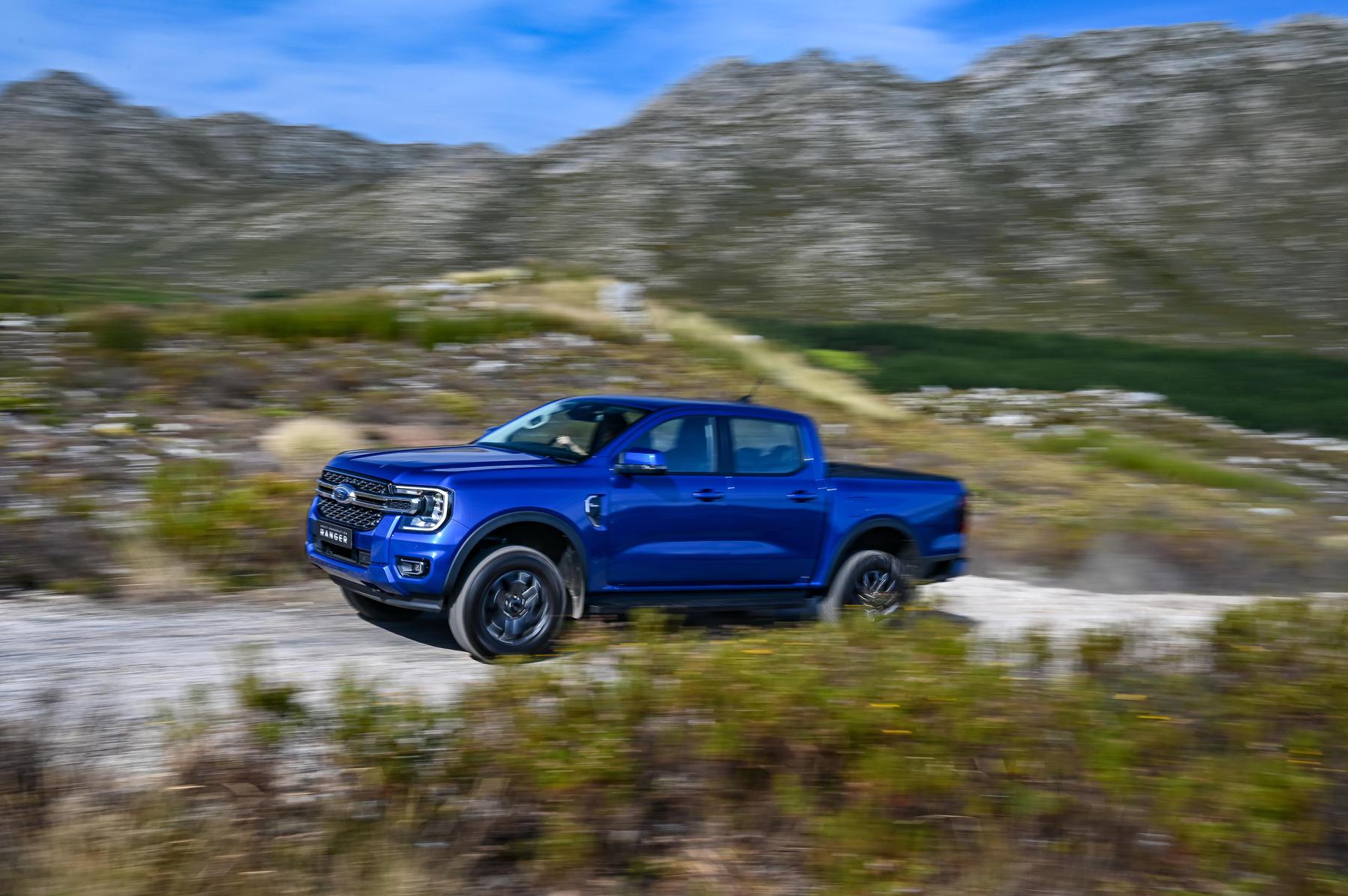
The Ranger’s ride quality (if perhaps a tad firmer than before) feels more composed on gravel roads.
Both derivatives featured a pleasantly light steering setup, which helps to make the sizeable bakkie manoeuvrable in tight spaces – and on narrow 4×4 tracks. The Wildtrak’s unique selling point is that its 4A (four-wheel-drive automatic) mode automatically provides all-wheel traction irrespective of road surface or -conditions – not only does it make the Ranger instantly more capable on tricky off-road routes in changeable conditions, but it will be of benefit when traversing tar roads in the rain (and snow). Outward visibility is great, but while we were completing the 4×4 course, the 360-degree camera system, which can display numerous views and angles, completely proved its worth.

Like its predecessor, the new Ranger is exceptionally capable across all terrain.
We simply selected the appropriate 4×4 mode, engaged low range and let the Ranger do the rest, which it did with aplomb. As was the case with Ford’s previous-generation bakkie, the new Ranger takes much of the stress or fear out of 4×4-ing by virtue of its off-road assistance systems, which is something that inexperienced 4×4 drivers will certainly appreciate.
There are some great-looking animations and graphics on the instrument cluster, but we don’t think it’s wise not to have a physical button for engaging something as important as the diff-lock (you must access it via the touchscreen). With the many ratios of the 10-speed auto ‘box, you can even simulate low-range mode and hill-descent control on less challenging terrain.

The customisable all-digital instrument cluster is new for the segment.
How much does the new Ford Ranger bakkie cost?
The new Ford Ranger is sold with a 4-year/120 000 km warranty, 4 years’ unlimited km roadside assistance and a 5-year/unlimited km corrosion warranty. Services are required every 15 000 km or once a year, while customers have the option of purchasing service or maintenance plans valid for up to 8 years/165 000 km. The warranty can be extended to 7 years or 200 000 km, while the roadside assistance can be extended for up to 2 years.
Ford also offers option packs that add items such as underbody protection, all-terrain tyres, cosmetic bodywork upgrades, and extra features. The list is extensive and detailed – we’d virtually double the length of this launch review if we listed all of them. For example, you can spend R31k on an XLT upgrade pack that adds Wildtrack-level gadgets and convenience features (if your budget can’t stretch to the flagship). Bear in mind, however, that the packs cannot be retrofitted.
Base
| 2.0L SiT Double Cab 4×2 6MT | R486 000 |
| 2.0L SiT Double Cab 4×4 6MT | R528 600 |
XL
| 2.0L SiT Double Cab XL 4×2 6MT | R529 900 |
| 2.0L SiT Double Cab XL 4×2 6AT | R544 400 |
| 2.0L SiT Double Cab XL 4×4 6MT | R607 300 |
| 2.0L SiT Double Cab XL 4×4 6AT | R621 900 |
XLT
| 2.0L SiT Double Cab XLT 4×2 6AT | R592 700 |
| 2.0L SiT Double Cab XLT 4×4 6AT | R669 800 |
| 2.0L BiT Double Cab XLT 4×2 10AT | R702 300 |
| 2.0L BiT Double Cab XLT 4×4 10AT | R782 100 |
Wildtrak
| 2.0L BiT Double Cab Wildtrak 4×2 10AT | R778 300 |
| 2.0L BiT Double Cab Wildtrak 4×4 10AT | R867 700 |
| 3.0L V6 Double Cab Wildtrak 4WD 10AT | R953 500 |
Want to buy a new or used Ford Ranger? Browse stock for sale now
Summary

We expect the new Ford Ranger to light up the sales charts in 2023.
Does the new Ford Ranger (T6.2) live up to the hype? Yes, it sure does. The Blue Oval’s new double-cab bakkie is significantly more advanced than the outgoing model and brings new levels of refinement and technology to the segment. The newcomer’s pricing looks quite competitive, but bear in mind that Ford’s list prices exclude service plans (at the product launch, FMCSA said that a 6-year/90 000 km service plan for the new Ranger could be purchased for “R18 740”).
However, given the all-around competence of the new Ranger package, its rivals have well and truly been put on notice. Right now, there’s no bakkie on sale that’s as advanced or, well, fresh as the new Ranger. The next-gen Hilux is still a few years away and there’s no doubt that Toyota will be examining the new Ranger in great detail in an effort to produce a credible rival. The new Volkswagen Amarok (a clone of the Ford Ranger) will come to market in the first quarter of 2023, and we suspect that it’ll be priced a bit higher than its Ford cousin. Sadly for Isuzu, its newish D-Max now feels a bit outdated by comparison. In fact, if you go on the visual appeal of the Ford’s interior, every other bakkie’s cabin feels outdated.
Based on our first impressions of the new Ranger, the South African bakkie segment’s goalposts have been moved significantly; Ford’s rivals will have to dig deep to match, let alone eclipse, the newcomer – as a product. The true test will be in years to come, when FMCSA’s claim of new levels of quality and reliability for this new model will be under scrutiny. Suffice it to say, we will directly compare the Blue Oval’s champion with its key rivals in the upcoming months.
Related content:
New Ford Ranger (2023) Specs & Price in SA
Volkswagen Amarok (2022) International Launch Review
